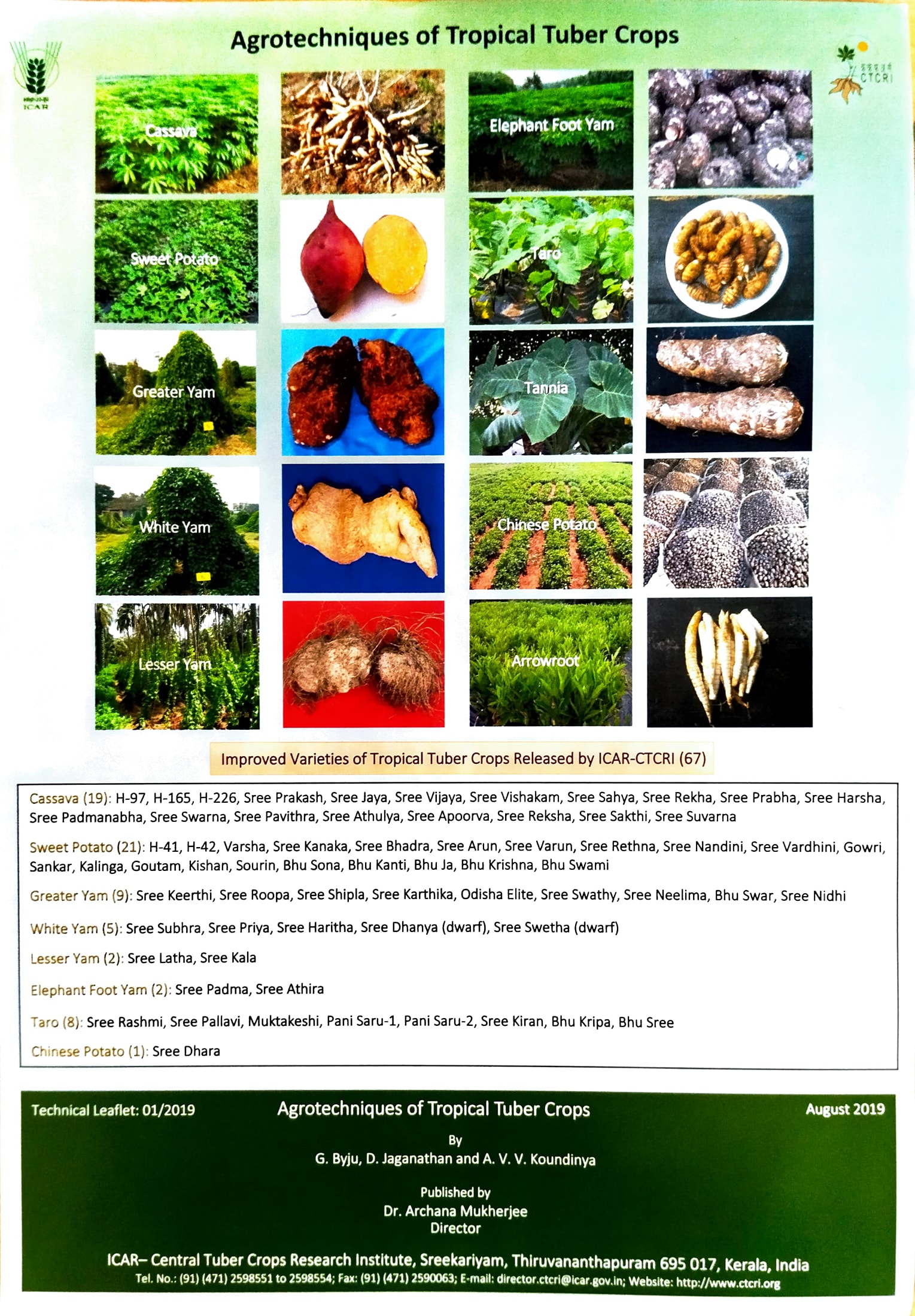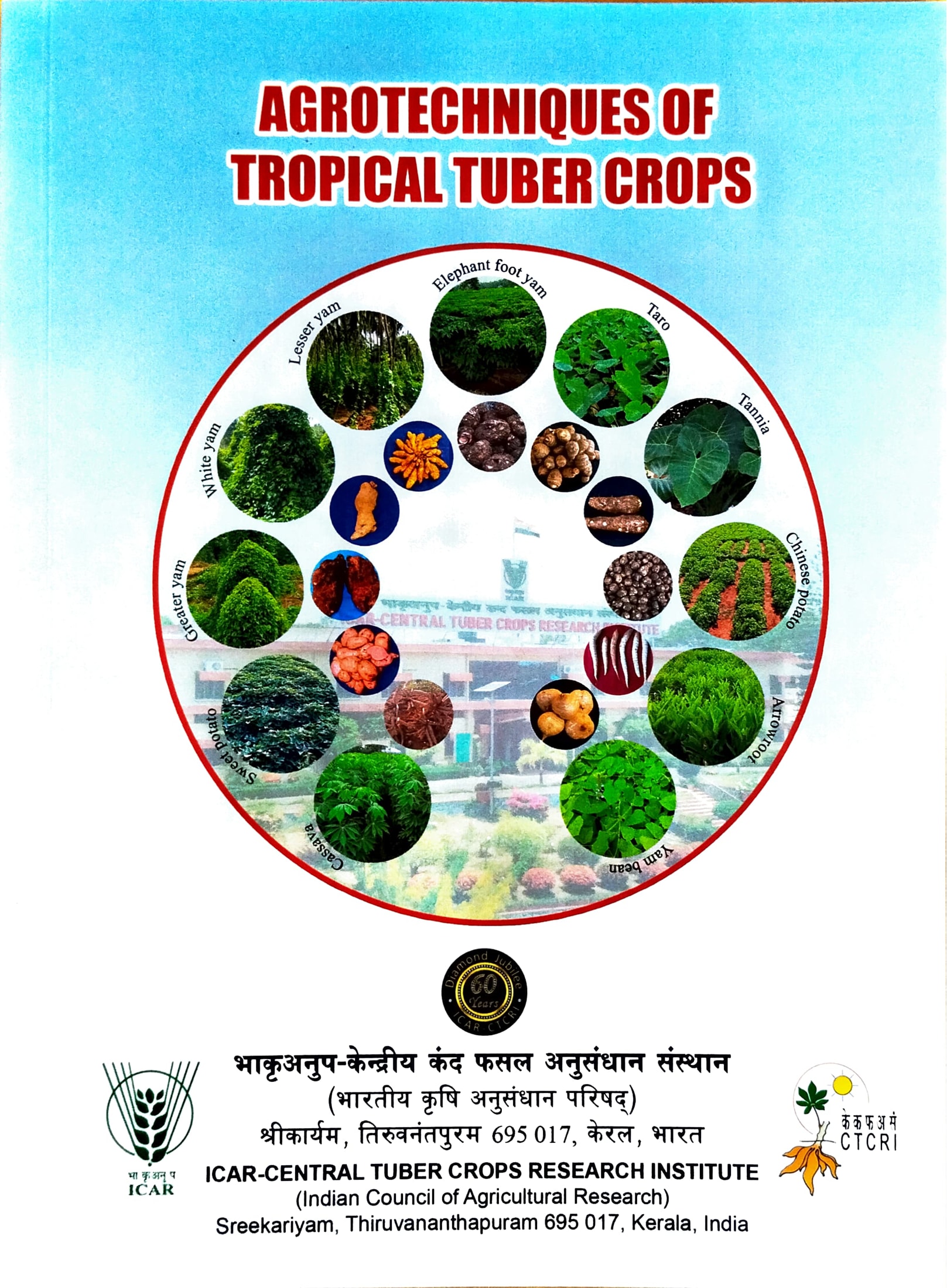
CROP PRODUCTION TECHNOLOGIES
- Technologies for rapid quality planting material production
- Registered seed growers
- Decentralized Seed Multiplier farmers (128 nos, 146 acres)
- Commercial seed growers
- Seed villages (117 nos, 332 acres)
- States: Kerala, Tamil Nadu, Odisha, Andhra Pradesh

|

|

|

|
|
|

|
- Scientific cultivation practices from planting till harvest for different agro-eco-zones
- Good agricultural practices
- Agro-techniques, soil fertility management, soil and water conservation methods for hill cassava production systems
- Technological support for establishment of farms
- Farm advisory services and field diagnostic visits

|

|
i. Resilient agro-ecology based cropping and farming systems
ii. Organic and natural farming
iii. Conservation agriculture (CA)
- Coconut based cropping systems
- Banana based cropping systems
- Rice based cropping systems
- Tuber crops-based cropping systems
- Integrated organic farming system model
ii. Organic and natural farming
- Organic production packages for cassava, elephant foot yam, yams, taro, tannia, Chinese potato, and arrowroot; 10-20% higher yield, 20-40% higher profit
- Organic package for cropping systems involving tuber crops: cassava-groundnut, cassava-vegetable cowpea, elephant foot yam + cucumber/amaranthus
- Cassava var. Sree Reksha identified as the most suitable for organic farming
- Geo-tagged characterization of 232 organic growers
- Technology for natural farming of cassava + vegetable cowpea- green gram
iii. Conservation agriculture (CA)
- CA Productive: with 13% higher yield over PoP
- CA Energy efficient: Highest energy use efficiency and energy productivity (+55% over POP) and lower energy input (-36.17%) over conventional
- CA Sustainable: Soil building nature and better soil health maintenance. Significantly improved soil pH (+0.65 unit), available K, Ca, Mg, Mn and Zn status
- CA Profitable: +32% profit and -9% production costs with higher net income and B:C ratio
 |
- Blanket nutrient recommendations
- Integrated plant nutrient system
- Low input management
- Customized plant nutrient formulations for tuber crops under intercropping in coconut
- Nutrient use efficient genotypes: The first K efficient cassava variety, Sree Pavithra; Two N use efficient genotypes: CR 43-8, W-19; NPK efficient genotypes: 7 III E3-5, CI-905, CI-906
- Alternatives to traditional manures: Green manuring in situ with cowpea as the best alternate organic manure resource for cassava followed by residue of the crop
- Nutrient management for CMD management: Identified nutrients viz., P, K, Ca, Si, Zn in the management of CMD expression
- Integrated soil and plant B management strategy to correct the suspected B deficiency disorders in tubers
Wealth from waste
- Nutrient rich organic manure Thippi compost from cassava starch factory solid waste
- Biochar from tuber crop wastes
Nutrient use efficient microbes identified
- N fixers (Bacillus cereus)
- P solubilizer (Bacillus megaterium)
- K solubilizer (Bacillus subtilis) to reduce chemical fertilizer use in elephant foot yam
- Fertilizer best management practices (FBMP) based on SSNM for 7 tuber crops for different agro eco-zones using 4R nutrient stewardship
- Technology for preparation of customized plant nutrient formulations and micronutrient formulations
- Zone-specific secondary and micronutrient inclusive customized fertilizers for 6 crops
- Six designer foliar liquid micronutrient formulations commercialized
- Ten Decision Support Systems (DSS)
- Drip irrigation schedules for cassava, elephant foot yam, taro, greater yam and sweet potato
- Fertigation schedule for cassava, elephant foot yam, greater yam and taro
- Water saving techniques for elephant foot yam and taro
- Water requirement and water productivity worked out
- Weed management in elephant foot yam, IWM in taro
- Weed control ground cover in cassava & taro
- Climate modeling studies: Calibrated and validated 5 Models, viz., ECOCROP, WOFOST, MaxEnt, CROPWAT & Aquacrop
- Climate resilient agriculture practices for cassava and yams: 14% higher yield, reduction in global warming potential
- Foliar application of 1% KNO3 or 1% solubor effective against drought stress
- Against heat stress, benzyl adenine 1000 ppm imparted tolerance
- Synthesis of near neutral zeolite (NNZ) for agricultural applications for enhancing soil C quality and conservation under climate change
- Important parameters of interest in zeolites (as soil amendments) such as pH, Exch.Na and CEC estimated
- The efficiency of NNZ in decomposition resistance of carbon in soils added with commonly available organic materials (as estimated from carbon dioxide emission rates) studied under controlled conditions
- Addition of zeolites decreased the very labile C, increased the recalcitrant C and cumulative quantity of carbon dioxide released in soil-organic manure mixture
- Crop physiology in response to climate change
- Cassava genotypes viz., Noorumuttan, Sree Pavithra and Sree Sahya superior under drought stress
- Sweet potato varieties, Kalinga, Bhu Swami, Sree Kanaka, Sree Varun, and Sree Vardhini performed better under drought stress




